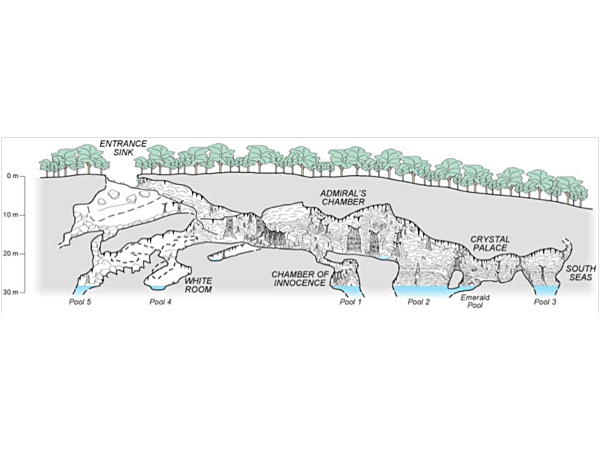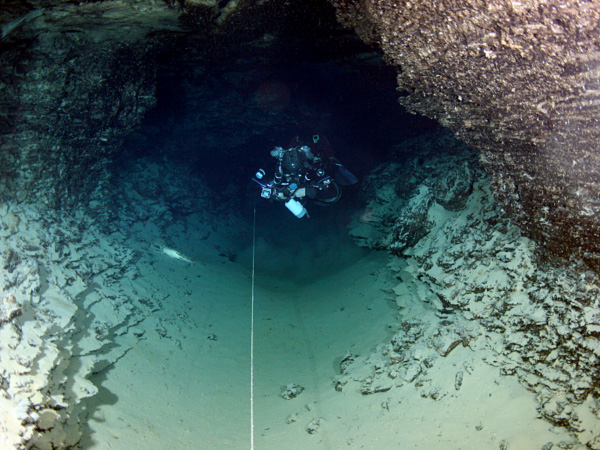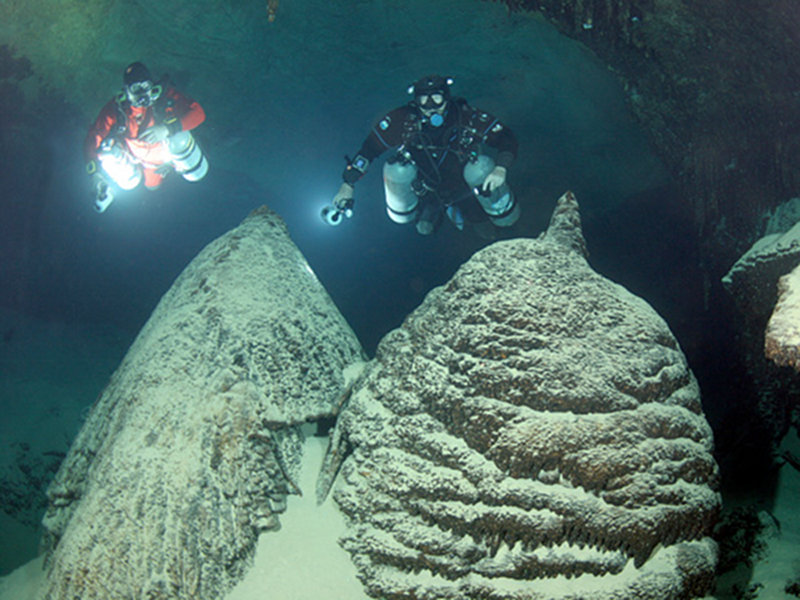
By Steve Blasco, Marine Engineering Geophysicist - Geological Survey of Canada
Bermuda is a volcanic seamount located 1000 km off the east coast of the United States in that part of the Western Atlantic known as the Sargasso Sea. The island was created by a series of mid-ocean volcanic eruptions that began about 35 million years ago, at a time when the Atlantic Ocean was much narrower. Subsequent plate tectonics and sea floor spreading have maintained Bermuda's distance relative to North America, while ever increasing its distance from Europe and Africa as the Atlantic Ocean widened. Thus, Bermuda has never been part of, or closer to, a continental landmass. As the top of the volcanic seamount was eroded down below sea level, corals began to grow around the margins, thus producing the only atoll in the North Atlantic.

Profile view of Admiral’s Cave show large, collapse chambers and sea level pools characteristic of dry caves in Bermuda. Image courtesy of Bob Richards, Bermuda Deep Water Caves 2011 Exploration, NOAA-OER. Download larger version (jpg, 837 KB).
Coral reef derived limestone, first deposited as coastal sand dunes, caps most of present-day Bermuda. The oldest limestone unit, known as the Walsingham Formation, outcrops along the eastern border of Harrington Sound, with younger limestone occurring on either side. Most of Bermuda’s caves are in this older limestone with about 90% of the island’s caves occurring in 10% of the land area. Approximately one million years ago, these limestone caves began forming during glacial periods, when sea level was as much as 100 m. At that time, the entire top of the Bermuda Seamount was exposed to air, creating a much larger island for freshwater catchment. As freshwater moved down through the porous limestone and then laterally towards the ocean, cave development began. Later, as glaciers on the continents melted and post-glacial sea levels rose, encroaching seawater drowned large portions of the caves. Continuing collapse of overlying rock into the large voids formed by limestone dissolution created the irregular chambers and fissure entrances that are commonly seen in Bermuda's dry caves (Fig. 1). Extensive networks of submerged passageways, developed primarily at depths between 17 and 20 m below present sea level, interconnect many otherwise isolated cave pools. These passages, only accessible to divers, are well decorated at all depths with impressive stalactites and stalagmites, confirming that the caves must have been dry and air-filled for much of their history.
Green Bay Cave is the longest cave in Bermuda, with more than 2 km of surveyed passage. This totally underwater cave has two known entrances and consists of large diameter passages oriented primarily across the peninsula separating Harrington Sound from the North Shore Lagoon. Additional smaller tunnels form a complex network of cave passages. Some of these passages show evidence of subterranean river flow carrying runoff from Harrington Sound towards the ocean during periods of lower sea level (Fig. 2). Massive stalactites and stalagmites are present in virtually all parts of the underwater cave and are another indication of the cave's long history as a dry cave (Fig. 3). Colder water is seasonally trapped in larger pockets on the floor of the cave and persists there over the summer, while warmer and/or slightly fresher water becomes trapped in domes on the ceiling of the cave as evidenced by differential coloring of the wall rock (Fig. 4).

Possible flooded stream passage cave at 18 m depth in the North Shore Passage of Green Bay Cave. Image courtesy of Ondrej Hindl, Bermuda Deep Water Caves 2011 Exploration, NOAA-OER. Download larger version (jpg, 1.9 MB).

Twin stalagmites in the North Shore Passage of Green Bay Cave. Image courtesy of Ondrej Hindl, Bermuda Deep Water Caves 2011 Exploration, NOAA-OER. Download larger version (jpg, 1.7 MB).
Biological zonation is evident as the diver progresses farther into the Green Bay Cave from the submerged entrance on the coast of Harrington Sound. Brightly colored sponges, hydroids, tunicates, and other encrusting organisms literally cover the walls and ceiling in areas close to the entrance. As a consequence of decreasing tidal currents and particulate matter suspended in the water, the density of these organisms declines with distance into the cave. In the much clearer waters of the deep cave interior, cave-limited species predominate.
Other large marine caves are located on the opposite side of Harrington Sound from Green Bay Cave. Two major cave systems in this area are the Walsingham and Palm Cave Systems. The Walsingham System is about 1.3 km long and comprises seven separate entrances. Of these, two are currently major tourist attractions in Bermuda. Palm Cave System with its five entrances is located immediately southwest of the Walsingham System. Tidal flow from Castle Harbour first moves through the Walsingham System and under an saddle valley of collapse origin before entering the Palm System and connecting to Harrington Sound. The Harrington Sound side of the Palm System is characterized by strong tidal currents and a profusion of colorful sponges and hydroids, encrusting the walls. Even the guideline through this section of the cave has become totally overgrown. Visibility is less than in other parts of the cave farther removed from tidal flow. Exposed bedrock and stalactites are darkly stained as in the passageways connecting higher flow sections of Walsingham Cave.
Government Quarry Cave was discovered during quarrying operations in 1969 but was destroyed when quarrying resumed in the mid-1980s. The cave contained two pools, one of which was initially explored to a complex fissure system reaching depths of 24 m and being one of the deepest underwater caves in Bermuda. However, before exploration could continue in the cave, large amounts of refuse and other debris were intentionally bulldozed into the pool to fill it before the quarrying away of the overlying rock. As a result of this dumping, water in the Government Quarry Cave and many adjacent caves turned anoxic and sulfurous.
Geological drilling operations at Government Quarry encountered a large cave at 18 m depth below sea level. The drill bit subsequently dropped to 33 m where volcanic bedrock was recovered. This would imply that caves in theGovernment Quarry area are the deepest in Bermuda and have been developed at the island's limestone basalt interface, averaging about 30 m below present sea level.

Wall rock in Green Bay Cave shows lighter colors at the ceiling and upper sections, contrasting with a dark brown iron or manganese stain below. Image courtesy of Ondrej Hindl, Bermuda Deep Water Caves 2011 Exploration, NOAA-OER. Download larger version (jpg, 2.6 MB).

Funnel-shaped depression in the sand floor of Tucker’s Town Cave, suggesting the presence of a lower level. Image courtesy of Cristian Lascu, Bermuda Deep Water Caves 2011 Exploration, NOAA-OER. Download larger version (jpg, 2.9 MB).
Tucker's Town Cave contains an immense underwater chamber that is devoid of speleothems so characteristic of other Bermuda caves. No passages have been found extending away from the chamber. Accumulation of dune-like sand deposits cover the cave floor in several locations. A funnel-shaped depression in the floor at 18 m depth was apparently caused by sand dropping into a lower level (Fig. 5). Although the ceiling shows evidence of a collapse origin, the only visible breakdown is present at the far end of the chamber from the entrance pool. Water in the cave is exceptionally clear with no sign of tidal currents.
Numerous other anchialine caves have been explored by divers, but many more remain to be discovered. Until now however, all known underwater caves lie beneath the land, with none extending to any significant extent out past the coastline and under the sea floor.